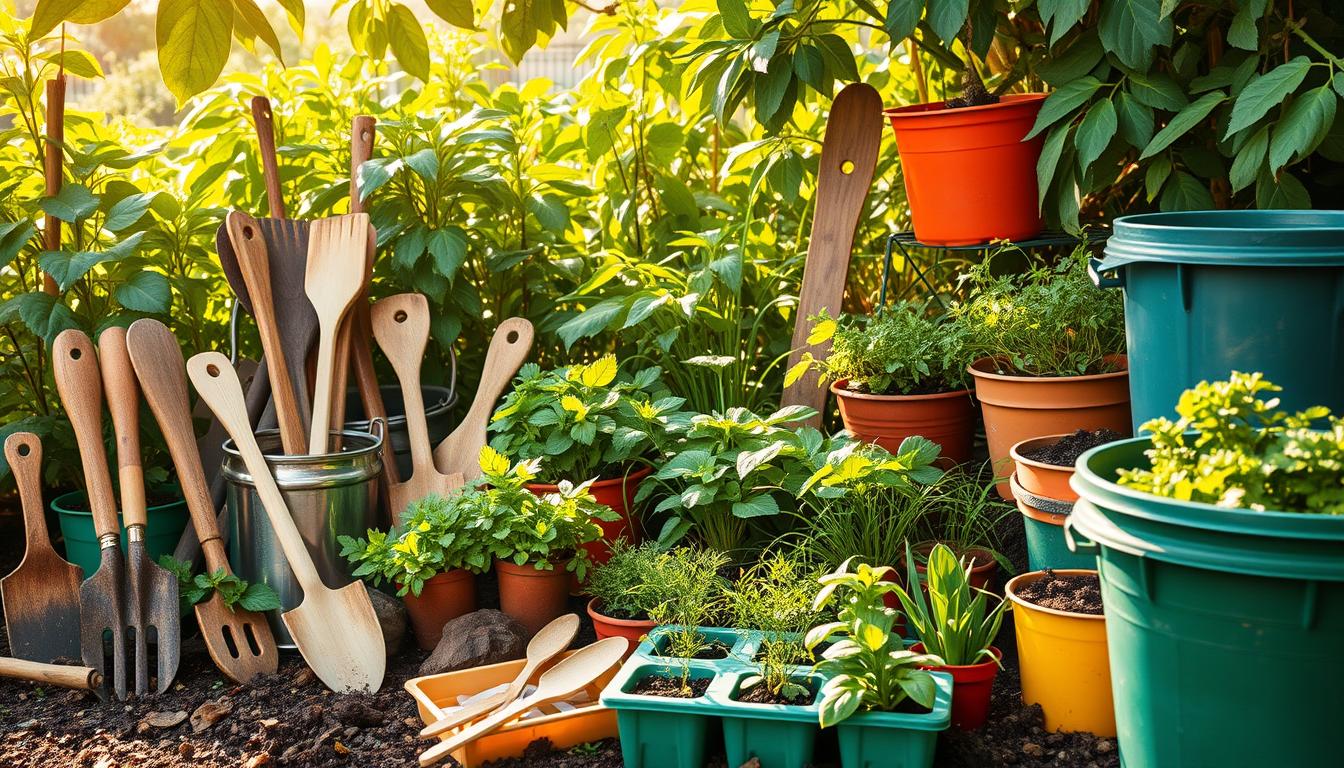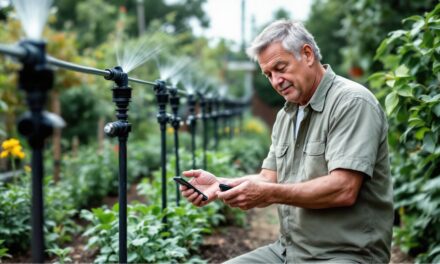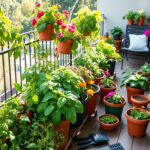Did you know that home gardens can cut carbon emissions by up to 50 pounds of CO2 per square meter each year? This fact shows how much sustainable gardening can help fight climate change. Using eco-friendly garden tools and organic supplies is more than a trend. It’s a key way to protect our planet.
Sustainable gardening is more than just taking care of plants. It’s about making your backyard a safe space for all living things. By picking eco-friendly tools, gardeners can lessen their environmental impact and grow stunning gardens.
Today, gardeners are seeing the value in green practices. Organic supplies now have new ways to keep plants and the environment safe. From compostable materials to saving water, green gardening is changing how we garden.
Key Takeaways
- Sustainable gardening reduces carbon emissions dramatically.
- Eco-friendly tools protect both plant and environmental health.
- Organic gardening supplies offer innovative environmental solutions.
- Every garden can contribute to ecological conservation.
- Green gardening practices are accessible to all skill levels.
Understanding Sustainable Garden Tools Basics
Eco-friendly gardening begins with choosing the right tools and materials. It’s not just a trend; it’s a way to protect our planet while making our gardens beautiful and productive.
Gardeners are key to saving the environment by picking tools wisely. The right tools can cut down on waste and harm to nature.
Importance of Quality and Durability
Opting for durable garden tools is a smart choice for eco-friendly gardening! They’ll make your tasks easier while helping reduce waste and promote sustainability. Let’s invest in tools that last and keep our gardens thriving!
These tools offer many benefits:
- They last longer, so you don’t need to replace them often.
- They save money in the long run because they’re cost-effective.
- They work better and more efficiently.
Materials to Look For and Avoid
When picking out eco-friendly garden tools, follow these guidelines:
| Recommended Materials | Materials To Avoid |
| Recycled aluminum | Single-use plastics. |
| FSC-certified wood | Non-recyclable composites. |
| Reclaimed steel | Petroleum-based materials. |
Environmental Impact of Tool Choice
Choosing eco-friendly gardening tools helps the environment. Soil health is key to sustainable gardening, and every tool choice affects the ecosystem.
Your garden tools are more than equipment—they’re partners in environmental stewardship.
By picking tools made from sustainable materials, gardeners can make stunning gardens. They also help native wildlife and lessen their ecological footprint.
Top Eco-Friendly Garden Tool Brands and Products
Choosing the right organic gardening supplies can change your gardening for the better. It also helps the planet. The market has many eco-friendly garden tools that work well and are good for the environment.
Sustainable Garden Tools Collection
Looking at sustainable garden brands, some stand out for their quality and care for the planet:
- Fiskars: Known for premium cutting tools with innovative design.
- Corona: Specializes in reliable pruning and hand tools.
- Felco: Produces high-quality pruning equipment.
Eco-conscious gardeners have many great options. For example, FELCO’s tools cost between $23 and $90. They’re made from 50% recycled aluminum and have safe handle grips.
Brand, product range and eco-friendly features chart:
| Brand | Product Range | Eco-Friendly Features |
| Garden Tower Project | Planting Containers | 100% UV stable, food-grade HDPE plastic. |
| Water Right | Garden Hoses | PVC and BPA-free polyurethane. |
| Elho | Garden Pots | 80% recycled plastic materials. |
For gardening gloves, there are eco-friendly options. They’re made from recycled materials or sustainable fabrics. Brands like COOLJOB and Bellingham offer choices that are good for the planet and still work well.
Sustainable gardening isn’t just about tools—it’s about making mindful choices that protect our planet.
The prices for top eco-friendly garden tools vary a lot. They range from $3 to $624. This means there’s something for every budget5. By choosing sustainable garden brands, you’re helping create a greener future.
Organic Gardening Supplies and Natural Solutions
Sustainable gardening is more than just growing plants. It’s about making a garden that helps both your garden and the planet. By picking the right organic gardening supplies, you can turn your garden into a green oasis.
Organic Gardening Supplies
Sustainable Planting Materials
Eco-friendly gardeners opt for sustainable, biodegradable materials, nurturing vibrant gardens while caring for the planet!
Here are some green options:
- Bamboo stakes for plant support.
- Jute twine for securing plants.
- Coconut coir planters.
- Peat pellets for seed starting.
Chemical-Free Pest Control Options
Using natural pest control keeps your garden safe from harmful chemicals. Organic fertilizers and beneficial insects are great for pest control.
Here are some effective methods:
- Introducing ladybugs to control aphids.
- Using neem oil as a natural insecticide.
- Planting companion crops that repel pests.
Earth-Friendly Garden Accessories
Green gardeners can make their spaces better with eco-friendly accessories. Items like compost bins, bamboo seed trays, and metal plant markers are great for gardening the green way.
Sustainable gardening is not just a practice, it’s a commitment to our planet’s future.
By using these organic gardening supplies and natural solutions, you’ll have a garden that’s not only lovely but also good for the planet.
Essential Garden Tool Maintenance and Care
Proper care of garden tools is key to sustainable gardening. Keeping your tools in good shape means they last longer and work better. Clean them after each use and store them dry, away from sunlight to stop rust.
Garden Tool Maintenance Tips
Some Essential Tips
- Pruning Tools: Sharpen pruners often for clean cuts and less damage to plants. Use bypass blades for branches up to one inch wide.
- Cutting Tools: Use anvil pruners for dead branches to avoid crushing tissue.
- Digging Tools: Apply linseed oil to wooden handles to prevent cracking and keep them strong.
Garden Wisdom said,
A well-maintained tool is a gardener’s best friend.
Here are some key maintenance tips for garden tool care:
- Clean tools after each use.
- Keep blades oiled and sharp.
- Store tools in a dry, protected area.
- Check for damage often.
Tool type and maintenance recommendation chart:
| Tool Type | Maintenance Recommendation |
| Hand Pruners | Sharpen blades, clean after use. |
| Spades | Use stainless steel heads, protect handles. |
| Garden Forks | Clean after use, oil metal parts. |
Pro Tip: Check with local community centers or manufacturers about tool repair clinics and replacement parts to support sustainable gardening practices.
Sustainable Watering Systems and Conservation
Water management is key in eco-friendly gardening. Smart irrigation cuts down water use while keeping gardens healthy.
Eco-Friendly Irrigation Systems
Water-Efficient Irrigation Methods
Drip irrigation is a game-changer for water saving in gardens. It delivers water right to the roots. This method can cut water use by 50% compared to old systems, perfect for green gardeners.
- Delivers water directly to plant roots.
- Reduces water waste by up to 50%.
- Provides 90% water irrigation efficiency.
Non-Toxic Garden Hoses
Choosing the right hose is vital for eco-friendly gardening. Opt for soaker hoses made from safe materials like polyurethane. These hoses are free from harmful chemicals like BPA, lead, and phthalates.
Sustainable gardening starts with mindful water management and safe gardening tools.
Rainwater Collection Systems
Rainwater harvesting is a big step towards saving water. It lets gardeners use less municipal water. These systems help reduce water use and support green gardening.
Irrigation method, water efficiency and environmental impact chart:
| Irrigation Method | Water Efficiency | Environmental Impact |
| Drip Irrigation | 90% | Low Water Waste. |
| Traditional Sprinklers | 65-70% | High Water Waste. |
Using these eco-friendly irrigation methods can make your garden water-saving and sustainable.
Eco-Friendly Soil Management and Composting
Sustainable soil management starts with knowing how important organic fertilizers and compost bins are. They help create a healthy garden ecosystem. By turning waste into organic fertilizers, gardeners can help plants grow strong.
To make good compost, you need to think about what you add. It’s all about mixing the right amounts of carbon and nitrogen materials.
- Browns (Carbon Materials): Straw, leaves, paper.
- Greens (Nitrogen Materials): Food scraps, grass clippings, manure.
But composting is just the start. Sustainable soil management also means understanding soil and keeping it healthy15. The microbes in the soil work with plants, helping them get the nutrients they need.
Composting factor and recommended specifications chart:
| Composting Factor | Recommended Specifications |
| Pile Size | 3’x3’x3′ to 5’x5’x5′ |
| Moisture Level | Like a wrung-out sponge. |
| Decomposition Time | 3-6 Months. |
Key practices for sustainable soil management include:
- Regular soil testing.
- Using cover crops.
- Avoiding synthetic fertilizers.
- Promoting biodiversity.
Experts said,
Organic gardening is not just about growing plants, but nurturing an entire ecosystem from the ground up.
Pro Tip: Always avoid adding diseased plants or non-compostable materials to your compost pile to maintain a healthy organic fertilizer system.
Plant Support Systems and Natural Materials
Sustainable gardening is more than just soil and seeds. It’s about using eco-friendly solutions for plant support. This way, your garden and the environment stay safe.
For those looking for green trellising, there are many options. These choices help your plants grow while keeping the planet safe.
Biodegradable Trellising Options
Embracing natural materials is a wonderful way to enhance your garden while being gentle to the planet!
Here are some eco-friendly choices:
- Bamboo stakes for lightweight climbing plants.
- Jute netting for vertical vegetable growth.
- Cedar wood trellises for durable, long-lasting support.
- Reclaimed wooden structures from local sources.
Sustainable Stakes and Cages
For bigger plants like tomatoes, you need strong support. Steel T-posts are strong and can be recycled. Wooden stakes from sustainable forests are also a good choice.
Natural Twine and Ties
Swap plastic ties for natural ones:
- Hemp twine.
- Jute garden ties.
- Cotton string.
- Velcro ties made from recycled materials.
Experts said,
Sustainable gardening is about working with nature, not against it.
Choosing eco-friendly plant support helps your garden thrive. It also protects our planet’s ecosystem.
Green Alternatives for Garden Storage and Protection
Eco-friendly garden storage is more than a trend. It’s a way to care for our planet while gardening. By choosing green storage, gardeners can protect their plants and the environment.
Looking for ways to protect your garden that are good for the planet? Try row covers made from natural materials. They keep plants safe and are eco-friendly.
- Repurpose wooden pallets for eco-friendly garden storage.
- Use recycled plastic containers for tool organization.
- Create sustainable shed designs with reclaimed materials.
- Implement natural ventilation in storage areas.
Strategic garden storage solutions can significantly reduce waste and promote environmental sustainability.
Here are some important tips:
| Storage Type | Eco-Friendly Features | Benefits |
| Wooden Shelters | Reclaimed or FSC-certified wood | Minimal environmental impact. |
| Row Covers | Biodegradable materials | Plant protection with low waste. |
| Vertical Storage | Recycled plastic or metal | Space-efficient design. |
Experts stated,
Sustainable garden protection is about making thoughtful choices that benefit both your garden and the environment.
Urban gardeners can make their storage more eco-friendly. Use smart designs that save space and protect tools. This helps your garden and the planet.
Conclusion: Making the Switch to Sustainable Gardening
Switching to sustainable gardening turns your garden into a green oasis. Using organic supplies and eco-friendly tools helps both the planet and your health. Today, 46% of gardeners choose organic fertilizers over chemicals.
Water saving is key in sustainable gardening. Rainwater harvesting can cut water use by 40%. Native plants need less water and help local wildlife. Using drip irrigation and mulching also saves water.
Sustainable gardening cuts down on waste and boosts ecosystem health. Upcycling can reduce waste by 70%. Natural pest control keeps good bugs safe. Growing your own food and using green tools lowers carbon emissions.
Starting a sustainable garden is fulfilling and beneficial. It’s about using organic supplies, saving water, and helping local ecosystems. Every action you take helps the environment and improves your health.
Frequently Ask Questions (FAQ)
What makes a garden tool eco-friendly?
Eco-friendly garden tools are made from materials like aluminum, steel, or wood certified by the Forest Stewardship Council (FSC). They are built to last, reducing waste and environmental harm. This is thanks to their durable design and responsible production.
How can I maintain my garden tools to make them more sustainable?
Keep your tools in top shape by cleaning them after each use. Store them in a dry spot, away from sunlight. Make sure blades are sharp and well-oiled. Using services for sharpening or local repair shops can also help extend their life and cut down on waste.
What are some recommended eco-friendly garden tool brands?
For cutting tools, Fiskars is a top choice. Corona is great for pruning tools. Felco offers excellent bypass pruning shears. For larger tools, Ames and True Temper are good options. For sustainable gardening gloves, Go-Compost and COOLJOB are excellent choices.
How can I reduce water usage in my garden?
Use water-efficient methods like rainwater collection systems. Choose non-toxic garden hoses, like the Eartheasy Premium Drinking Water Safe Garden Hose. Also, plant native species that need less water.
What should I use instead of peat-based compost?
Opt for alternatives like coconut coir, biochar, or homemade compost. These options are better for the environment and provide great nutrients for your garden.
What are sustainable alternatives for plant supports?
Use biodegradable materials like jute or bamboo stakes for trellising. Choose Velcro Garden Ties made from recycled materials or natural twine instead of plastic.
How can I control pests without harmful chemicals?
Try natural pest control methods and beneficial insects. Use row covers made from biodegradable materials. Focus on creating a balanced garden ecosystem to naturally keep pests away.
What type of gardening gloves are most eco-friendly?
Look for gloves made from compostable or recycled materials. Sustainable fabrics like bamboo are also good options. Brands like Hestra, Bellingham, and Watson Gloves offer eco-friendly choices.
How do I choose sustainable seed starting materials?
Use biodegradable materials like toilet paper rolls or peat pellets. Choose planters from natural materials like bamboo or coconut coir.
What are some tips for creating an eco-friendly garden space?
Focus on using native plants and organic supplies. Save water and compost. Reduce plastic use. Choose sustainable materials for accessories and prefer biodegradable and reusable options.




















